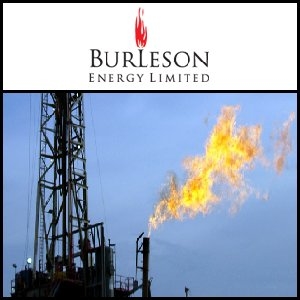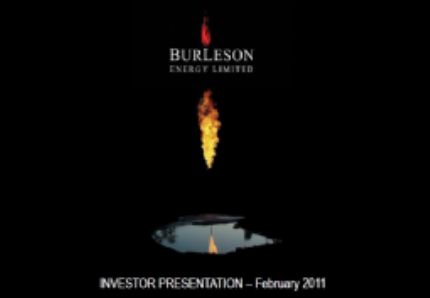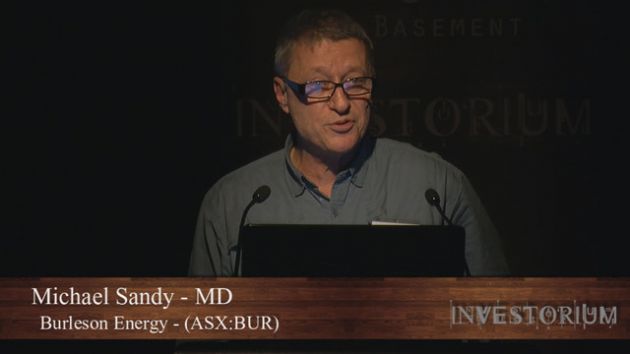
Burleson Energy Limited (ASX:BUR) Heintschel Field Evaluation Confirms Sizeable Gas And Condensate Accumulation
Sydney, July 28, 2010 AEST (ABN Newswire) - Burleson Energy Limited ( ASX:BUR) (BUR) is pleased to advise that AKG, operator of our projects in Texas, has completed in-house volumetric resource calculations for the Heintschel gas condensate field, and has confirmed a potentially sizeable gas condensate accumulation. The field was discovered by the Heintschel # 1 (H#1) well drilled last April and production tested earlier this month. The well is currently on an extended flow test and produced gas and condensate are being sold.
ASX:BUR) (BUR) is pleased to advise that AKG, operator of our projects in Texas, has completed in-house volumetric resource calculations for the Heintschel gas condensate field, and has confirmed a potentially sizeable gas condensate accumulation. The field was discovered by the Heintschel # 1 (H#1) well drilled last April and production tested earlier this month. The well is currently on an extended flow test and produced gas and condensate are being sold.
AKG has calculated contingent recoverable resources in the Heintschel structure to range from 25.6 billion cubic feet of gas (Bcf) and 0.46 million barrels of condensate (mmbc) to 88 Bcf and 1.6 mmbc - with a mid case estimate of 59 Bcf and 1.1 mmbc.
H#1 intersected 282 feet (86 metres) of gross sands, and a minimum of 160 ft (49m) of net sands and a minimum of 111 ft (34m) of net gas pay - this is considerably more gas pay and a much thicker hydrocarbon column than anticipated in the pre-drill prognosis. See Burleson's earlier ASX releases for more detail on the results of the well.
The 3D seismic covering the Heintschel field has been remapped by after incorporating the H#1 well results, which has enlarged the structural closure to approximately 4460 acres. It now includes four structural culminations, two of which were previously considered to be separate structures.
Contingent recoverable resources have been determined as follows (see below for some technical detail regarding how these numbers were derived):
----------------------------------------------- Gas Condensate Number of wells (BCF) (mmbc) to develop-----------------------------------------------Low Case 25.6 0.465 4-8Mid Case 58.9 1.07 6-16High Case 87.7 1.6 12-24-----------------------------------------------
The BUR board has decided to focus on the Heintschel field development as its main near term priority - to evaluate the field and to establish a cash flow stream from gas and condensate sales.
The forward program is to fracture stimulate and test the H#1 well, which has flowed between 1.0 and 1.4 mmcfd of gas plus condensate prior to any stimulation (fraccing). Fraccing equipment is in short supply and the H#1 well is on waiting lists with 3 fraccing companies. It is uncertain at this stage when H#1 will be fracced but it is likely to be sometime in September.
After the H#1 has been fracced, well performance will be monitored and evaluated for approximately 1 month. This will enable the design of an efficient appraisal and development drilling programme for the Heintschel field, which will follow therewith. It is currently anticipated that drilling will recommence on the Heintschel field during the month of October BUR Managing Director, Michael Sandy commented -
"These impressive numbers highlight the fact that with our first Wilcox well in the Colorado County 3D project, BUR has made a significant and potentially company-making discovery. BUR has a working interest of 38% in the Heintschel field and a ~30% Net Revenue Interest (NRI, i.e. after royalties are taken out). The company is now moving into a development phase for the field and, while we will recommence drilling wildcat exploration wells in the near future, the immediate focus will be on evaluating H#1 (while earning valuable revenue) and then shifting to drilling Heintschel appraisal/development wells.
To put the find in perspective: assuming the mid case of 59 bcf and 1.1 mmbc and using the current gas and oil prices, the Heintschel field would deliver, over the next several years, revenues net to BUR's NRI of over A$125 million. This is for a company with a current market cap of just A$12m.
BUR's share of costs of a development of this scale (assuming 12 wells) would be ~A$13m with operating costs of ~ $A0.3m per year. Taxes rates are low (condensate ~ 4% and gas ~7.5%).
This undiscounted revenue number of A$125 m does not include the real possibility of significantly greater resources than 59 Bcf and 1.1 mmbc in the Heintschel field (see High Case).
But Heintschel is not BUR's only asset. There are the chalk royalties we receive from 2 wells; revenues from the Brasher 1 well; upcoming future revenues from the recent Joann gas condensate discovery; and, the updip potential recognised in the Moeller prospect. In addition there are a large number of Wilcox and other prospects in BUR's inventory. "
Technical detail - Heintschel gas and condensate resources analysis
There are 5 separate gas charged reservoir sands in H#1 with additional younger sands likely to occur in the eastern part of the field. The most significant sand in terms of gas volumes is the middle sand and is denoted here as Sand C. No gas water contact was seen in Sand C in the H#1 well so the gas volumes within that sand across the structure are unknown at this stage.
AKG developed three cases based on the location of the gas water contact (GWC) for the C sand. The Low Case uses the volume of gas sand to the "lowest known gas" (LKG) in Sand C (i.e. it assumes there is no gas below that seen in the well). The Mid Case assumes a GWC at the "spill point" for the gas in Sand C as mapped using the 3D seismic. The High Case, assumes additional sands occur in the high area in the east of the Heintschel field where an additional 170' (52m) of section has been mapped. It assumes the same net- to- gross sand ratio for that high area, as occurs in the H#1 well reservoir package.
For the complete Burleson announcement including Heintschel Resource Figures, please refer to the following link:
http://www.abnnewswire.net/media/en/docs/63406-ASX-BUR-499025.pdf
Contact
Mike Sandy
Managing Director
Tel: +61-2-9450-2002
Fax: +61-2-9986-1753
Email: info@burlesonenergyltd.com
www.burlesonenergyltd.com
| ||
|





